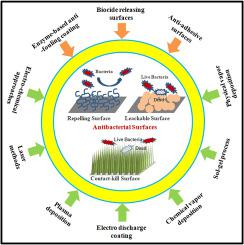Colloid and Interface Science Communications ( IF 4.7 ) Pub Date : 2021-07-15 , DOI: 10.1016/j.colcom.2021.100464 Sanjay Kumar 1 , Dijendra Nath Roy 2 , Vidyut Dey 1

|
The development of microorganisms' colonies creates a three-dimensional structure named biofilm, which helps microorganisms attach to the substratum to survive. The microorganisms' survival strategy process is usually responsible for the corrosion of biomaterial and mediating microbial infection to the user. Different biomaterials are used for human use, such as polymeric, ceramic, metallic, and composite biomaterials. The antimicrobial surfaces on biomaterials are developed by making the surface microbial repelling surfaces, microbes killing surfaces, anti-adhesive surfaces, or biocide releasing surfaces., The topography of the surface has to be modified to restrict the growth of the microbes. One may use any of these techniques, such as the vapour deposition process, sol-gel process, electrical discharge coating process, plasma deposition process, lasers mediated process, electrochemical approach, etc. This modified surface of biomaterial demonstrates inhibition of microbes-mediated corrosion. This review provides a complete insight into how biomaterials become resistant to biofouling-mediated corrosion.
中文翻译:

对创建生物材料抗微生物表面以干预生物污垢的技术的全面审查
微生物菌落的发育创造了一种称为生物膜的三维结构,它有助于微生物附着在基质上生存。微生物的生存策略过程通常负责生物材料的腐蚀和介导微生物对用户的感染。人类使用不同的生物材料,例如聚合物、陶瓷、金属和复合生物材料。生物材料上的抗菌表面是通过使表面微生物排斥表面、微生物杀死表面、抗粘附表面或杀生物剂释放表面来开发的。必须改变表面的形貌以限制微生物的生长。可以使用这些技术中的任何一种,例如气相沉积工艺、溶胶-凝胶工艺、放电涂覆工艺、等离子沉积过程、激光介导的过程、电化学方法等。这种改性的生物材料表面表现出对微生物介导的腐蚀的抑制作用。这篇综述提供了对生物材料如何变得对生物污垢介导的腐蚀具有抵抗力的完整见解。











































 京公网安备 11010802027423号
京公网安备 11010802027423号